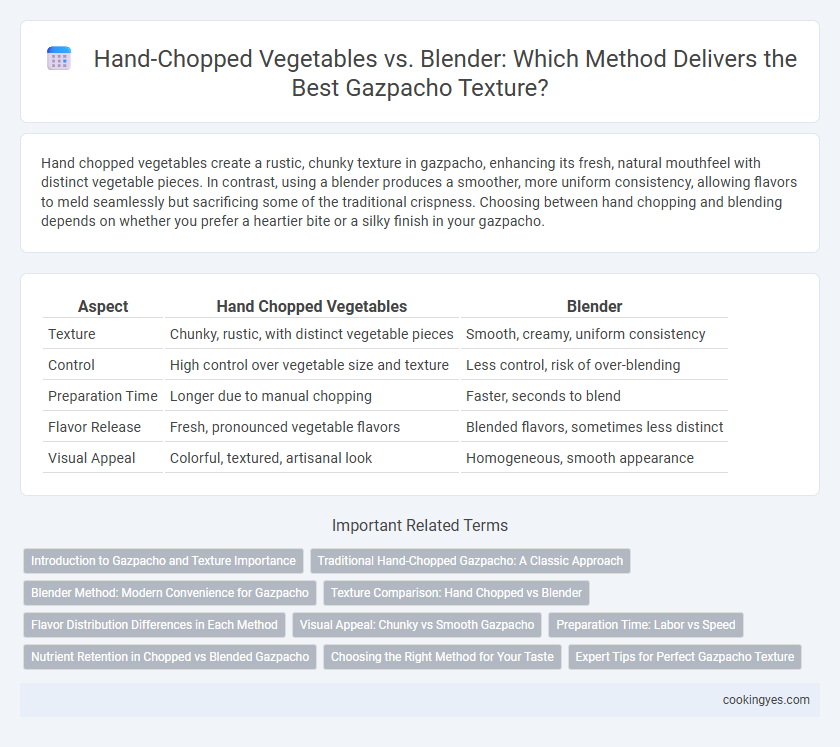Hand chopped vegetables create a rustic, chunky texture in gazpacho, enhancing its fresh, natural mouthfeel with distinct vegetable pieces. In contrast, using a blender produces a smoother, more uniform consistency, allowing flavors to meld seamlessly but sacrificing some of the traditional crispness. Choosing between hand chopping and blending depends on whether you prefer a heartier bite or a silky finish in your gazpacho.
Table of Comparison
| Aspect | Hand Chopped Vegetables | Blender |
|---|---|---|
| Texture | Chunky, rustic, with distinct vegetable pieces | Smooth, creamy, uniform consistency |
| Control | High control over vegetable size and texture | Less control, risk of over-blending |
| Preparation Time | Longer due to manual chopping | Faster, seconds to blend |
| Flavor Release | Fresh, pronounced vegetable flavors | Blended flavors, sometimes less distinct |
| Visual Appeal | Colorful, textured, artisanal look | Homogeneous, smooth appearance |
Introduction to Gazpacho and Texture Importance
Gazpacho, a traditional Spanish cold soup, relies heavily on texture to balance freshness and flavor. Hand chopping vegetables creates a coarser, chunkier consistency that highlights the natural crispness of ingredients, while a blender produces a smoother, more homogenous texture. Choosing the right method impacts the sensory experience, with hand chopping preserving individual vegetable integrity and enhancing the rustic appeal of authentic gazpacho.
Traditional Hand-Chopped Gazpacho: A Classic Approach
Traditional hand-chopped gazpacho preserves the vibrant texture of fresh vegetables, offering a more rustic and authentic mouthfeel compared to the homogenous blend produced by blenders. Using a sharp knife to finely dice tomatoes, cucumbers, peppers, and onions maintains the integrity of each ingredient, enhancing the overall flavor complexity and visual appeal. This classic approach honors the Andalusian heritage of gazpacho, emphasizing natural textures and a handcrafted quality prized by purists.
Blender Method: Modern Convenience for Gazpacho
Using a blender for gazpacho delivers a smooth, consistent texture that highlights the soup's fresh flavors with ease. This modern convenience speeds up preparation and allows precise control over the blend, ensuring an even mixture of tomatoes, cucumbers, peppers, and garlic. The blender method is ideal for achieving a silky gazpacho that retains vibrant color and enhances the overall dining experience.
Texture Comparison: Hand Chopped vs Blender
Hand-chopped vegetables in gazpacho create a coarser, chunkier texture that enhances the rustic and fresh mouthfeel of the soup, preserving individual vegetable pieces. In contrast, using a blender produces a smoother, more uniform texture, which can result in a creamier consistency but may sacrifice the distinct vegetable bite. The choice between hand chopping and blending significantly impacts the sensory experience of gazpacho, influencing both texture and overall presentation.
Flavor Distribution Differences in Each Method
Hand chopped vegetables in gazpacho create a varied texture with distinct, fresh bursts of flavor due to uneven particle sizes that preserve individual vegetable integrity. Blender processing produces a smooth, uniform texture, allowing flavors to blend seamlessly and distribute evenly throughout the soup. The choice between hand chopping and blending significantly influences flavor perception, with hand chopping emphasizing individual ingredient notes and blending enhancing overall harmony.
Visual Appeal: Chunky vs Smooth Gazpacho
Hand chopped vegetables in gazpacho create a visually appealing, chunky texture that showcases distinct, vibrant pieces of tomato, cucumber, and bell pepper, enhancing the dish's rustic charm. In contrast, blender-prepared gazpacho offers a smooth, uniform consistency that emphasizes a creamy, refined presentation. The choice between chunky and smooth textures directly influences the gazpacho's visual appeal, catering to different aesthetic and sensory preferences.
Preparation Time: Labor vs Speed
Hand chopping vegetables for gazpacho enhances texture with distinct, chunky pieces but requires significantly more preparation time and labor intensity. Using a blender dramatically reduces preparation time by swiftly pureeing ingredients, resulting in a smoother texture with minimal effort. This trade-off between labor and speed influences the overall tactile experience and time efficiency in gazpacho preparation.
Nutrient Retention in Chopped vs Blended Gazpacho
Hand chopped vegetables in gazpacho preserve more nutrients and maintain firmer textures compared to blended versions, which can cause greater cell rupture and nutrient loss. Blending increases oxidation and heat from the blade, leading to reduced levels of vitamin C and antioxidants in the soup. Nutrient retention is optimized when vegetables are gently chopped by hand, enhancing both the texture and health benefits of gazpacho.
Choosing the Right Method for Your Taste
Hand chopping vegetables for gazpacho preserves a chunkier, more rustic texture that highlights individual flavors and offers a traditional dining experience. Using a blender creates a smoother, creamier consistency ideal for those who prefer a velvety mouthfeel and evenly blended taste. Selecting between hand chopping and blending depends on personal preference for texture, with hand chopping emphasizing freshness and bite, while blending delivers a uniform, silky soup.
Expert Tips for Perfect Gazpacho Texture
For authentic gazpacho texture, hand-chopped vegetables preserve the crispness and distinct vegetable pieces, creating a rustic and refreshing bite. Experts recommend finely dicing tomatoes, cucumbers, and peppers to balance texture without creating a puree. Using a blender tends to produce a smoother, creamier soup, which can be less traditional but preferred for those seeking a silky consistency.
Hand Chopped Vegetables vs Blender for gazpacho texture Infographic

 cookingyes.com
cookingyes.com